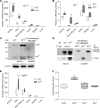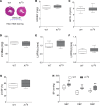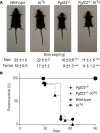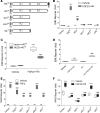FGF23 expression is stimulated in transgenic α-Klotho longevity mouse model
- PMID: 31801907
- PMCID: PMC6962016
- DOI: 10.1172/jci.insight.132820
FGF23 expression is stimulated in transgenic α-Klotho longevity mouse model
Abstract
Observations in transgenic α-Klotho (Kl) mice (KlTg) defined the antiaging role of soluble Klotho (sKL130). A genetic translocation that elevates sKL levels in humans is paradoxically associated with increased circulating fibroblast growth factor 23 (FGF23) levels and the potential of both membrane KL (mKL135) and sKL130 to act as coreceptors for FGF23 activation of fibroblast growth factor receptors (FGFRs). Neither FGF23 expression nor the contributions of FGF23, mKL135, and sKL130 codependent and independent functions have been investigated in KlTg mice. In the current study, we examined the effects of Kl overexpression on FGF23 levels and functions in KlTg mice. We found that mKL135 but not sKL130 stimulated FGF23 expression in osteoblasts, leading to elevated Fgf23 bone expression and circulating levels in KlTg mice. Elevated FGF23 suppressed 1,25(OH)2D and parathyroid hormone levels but did not cause hypophosphatemic rickets in KlTg mice. KlTg mice developed low aldosterone-associated hypertension but not left ventricular hypertrophy. Mechanistically, we found that mKL135 and sKL130 are essential cofactors for FGF23-mediated ERK activation but that they inhibited FGF23 stimulation of PLC-γ and PI3K/AKT signaling. Thus, increased longevity in KlTg mice occurs in the presence of excess FGF23 that interacts with mKL and sKL to bias FGFR pathways.
Keywords: Bone Biology; Cardiovascular disease.
Conflict of interest statement
Figures






Similar articles
-
Soluble Klotho causes hypomineralization in Klotho-deficient mice.J Endocrinol. 2018 Jun;237(3):285-300. doi: 10.1530/JOE-17-0683. Epub 2018 Apr 9. J Endocrinol. 2018. PMID: 29632215
-
Klotho ablation converts the biochemical and skeletal alterations in FGF23 (R176Q) transgenic mice to a Klotho-deficient phenotype.Am J Physiol Endocrinol Metab. 2009 Jan;296(1):E79-88. doi: 10.1152/ajpendo.90539.2008. Epub 2008 Nov 4. Am J Physiol Endocrinol Metab. 2009. PMID: 18984852
-
FGF23 induced left ventricular hypertrophy mediated by FGFR4 signaling in the myocardium is attenuated by soluble Klotho in mice.J Mol Cell Cardiol. 2020 Jan;138:66-74. doi: 10.1016/j.yjmcc.2019.11.149. Epub 2019 Nov 21. J Mol Cell Cardiol. 2020. PMID: 31758962 Free PMC article.
-
Effects of klotho deletion from bone during chronic kidney disease.Bone. 2017 Jul;100:50-55. doi: 10.1016/j.bone.2017.02.006. Epub 2017 Feb 20. Bone. 2017. PMID: 28232146 Free PMC article. Review.
-
α-Klotho's effects on mineral homeostasis are fibroblast growth factor-23 dependent.Curr Opin Nephrol Hypertens. 2018 Jul;27(4):229-235. doi: 10.1097/MNH.0000000000000415. Curr Opin Nephrol Hypertens. 2018. PMID: 29851418 Free PMC article. Review.
Cited by
-
Klotho Modulates Pro-Fibrotic Activities in Human Atrial Fibroblasts through Inhibition of Phospholipase C Signaling and Suppression of Store-Operated Calcium Entry.Biomedicines. 2022 Jul 1;10(7):1574. doi: 10.3390/biomedicines10071574. Biomedicines. 2022. PMID: 35884879 Free PMC article.
-
Skeletal endocrinology: where evolutionary advantage meets disease.Bone Res. 2021 May 28;9(1):28. doi: 10.1038/s41413-021-00149-x. Bone Res. 2021. PMID: 34050126 Free PMC article. Review.
-
Lactate and Lactylation in the Brain: Current Progress and Perspectives.Cell Mol Neurobiol. 2023 Aug;43(6):2541-2555. doi: 10.1007/s10571-023-01335-7. Epub 2023 Mar 16. Cell Mol Neurobiol. 2023. PMID: 36928470 Free PMC article. Review.
-
Soluble α-klotho and heparin modulate the pathologic cardiac actions of fibroblast growth factor 23 in chronic kidney disease.Kidney Int. 2022 Aug;102(2):261-279. doi: 10.1016/j.kint.2022.03.028. Epub 2022 May 2. Kidney Int. 2022. PMID: 35513125 Free PMC article.
-
A Land of Controversy: Fibroblast Growth Factor-23 and Uremic Cardiac Hypertrophy.J Am Soc Nephrol. 2020 Jul;31(7):1423-1434. doi: 10.1681/ASN.2020010081. Epub 2020 Jun 11. J Am Soc Nephrol. 2020. PMID: 32527977 Free PMC article. Review.
References
Publication types
MeSH terms
Substances
Grants and funding
LinkOut - more resources
Full Text Sources
Other Literature Sources
Molecular Biology Databases
Research Materials
Miscellaneous

